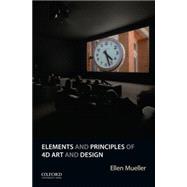Elements and Principles of 4D Art and Design is a core text for 4D foundational studies, offering students an accessible and hands-on introduction to the new elements and principles of time-based art. Suitable for both majors and non-majors, the book begins by reviewing basic aesthetic concepts and the principles and elements of 2- and 3D design to help students make connections between more familiar art forms and the new world of 4D design. Through a range of exercises and activities, students will hone improvisation, brainstorming, and critical thinking skills while gaining experience in a range of technologies related to 4D design such as simple video and audio recording and editing.
Visit www.oup.com/us/mueller for additional material, including:
- Interviews, videos, and audio files for a selection of examples cited throughout the text
- Links and suggestions for online technical resources related to DSLR camera use, video editing, audio recording and editing, and stop-motion animation
- Links to additional resources on artists and art for more in-depth learning








